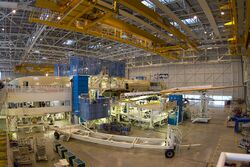Aerospace manufacturer
(manufacturer, military-industrial complex) | |
|---|---|
 | |
| An industry regarded as vitally strategic for great powers |
An aerospace manufacturer is a company or individual involved in the various aspects of designing, building, testing, selling, and maintaining aircraft, aircraft parts, missiles, rockets, drones or satellites and spacecraft. Aerospace is a high technology industry, and of vital strategic importance, both military and for the civilian economy.
Industry Size
In 2018, the countries with the largest industry were led by the United States with $408.4 Bn (49%) followed by France with $69 Bn (8.2%) then China with $61.2 Bn (7.3%), United Kingdom with $48.8 Bn (5.8%), Germany with $46.2 Bn (5.5%), Russia with $27.1 Bn (3.2%), Canada with $24 Bn (2.9%), Japan with $21 Bn (2.5%), Spain with $14 Bn (1.7%) and India with $11Bn (1.3%). The top 10 countries represent $731 Bn or 87.2% of the whole industry.[1]
Industry concentration
The importance of investments and the length of the cycles necessary to develop a new device have precipitated the regrouping of manufacturers through takeovers and mergers. This movement is very visible for airframe and engine manufacturers, a little less for subcontractors.
In Europe, Airbus is the dominant producer, and ranks among the 2 major world manufacturers with Boeing. In year 2000, European Aeronautic Defense and Space Company (EADS) was formed, bringing together the activities of the manufacturers Aerospatiale, DASA and CASA. In January 2014, EADS was reorganised as Airbus Group NV, with three divisions (Airbus, Airbus Defence and Space, and Airbus Helicopters).
In Germany, one manufacturer, DASA (Deutsche Aerospace AG) resulting from the merger of Messerschmitt, Bölkow and Dornier formed the second pillar of EADS, later Airbus. In 2010, the aerospace sector in Germany employed nearly 6,200 people and generated sales of around 2 billion euros.
In France there are only two airframe manufacturers: Aérospatiale absorbed since 2000 by European Aeronautic Defense and Space Company and Dassault - the only French combat aircraft producer -, an engine manufacturer: SNECMA and a major equipment manufacturer: Thales. Aérospatiale, created in 1970, comes from more than a dozen companies created before the Second World War.
In the United Kingdom, one manufacturer: British Aerospace and an engine manufacturer: Rolls-Royce followed an identical course; British Aerospace, for example, originated from Avro, Blackburn, De Havilland, Hawker, Armstrong, Vickers, Bristol, etc.
In the United States, there were 17 manufacturers of military aeronautics. Since the end of the 20th century there were only three: Boeing, Northrop Grumman, and Lockheed Martin. An identical movement of concentration led to mergers within Boeing (Boeing, McDonnell, Douglas, North American Aviation), General Dynamics (Gulfstream), Northrop Grumman (Northrop, Grumman, Westinghouse, Teledyne-Ryan, TRW), Lockheed-Martin (Lockheed, Martin Marietta) for airframes, Rockwell Collins for equipment, United Technologies and General Electric for engines. In 2008, the US aerospace industry represented approximately 3,100 companies employing 503,900 people. In May 2011, it employed 473,120 people[2].
In parallel to these restructurings, new manufacturers are emerging in industrialized countries (in China with Comac, South America with Embraer in Brazil). The evolution of the aeronautical industry of the countries resulting from the Soviet block (Eastern Europe, Russia, etc.) and of its satellite countries remains to be determined. In Russia, the OAK was created in February 2006 (in Russian: Объединённая авиастроительная корпорация or Unified Aeronautical Company), a consortium bringing together the main Russian civil and military construction units: Sukhoi, MiG, Ilyushin or Tupolev and Irkut. Important ex-Soviet sites such as the Tashkent Aircraft Construction Association collapsed.
Finally, Japan is also launching projects. With Mitsubishi Heavy Industries, the Mitsubishi MRJ jet is an already very advanced project. Kawasaki Heavy Industries is also developing a twinjet project.
At the moment, many of these manufacturers are dependent on American and European industry for their engines and equipment.
Examples
| Page name | Description |
|---|---|
| Airbus | Produces 50% of all jet aircraft in the world. Largest airliner manufacturer during the 2020s. Accused of bribery of multiple countries. Received a ban from a group of dozens of banks for "involvement in nuclear weapons production". |
| BAE Systems | A global arms company, with interests also in civilian avionics and engineering. Its subsidiaries are also involved in providing intelligence, personnel and logistics support to US/UK military. |
| Boeing | US based arms manufacturer which also makes civilian aircraft that since the 1990s have became known for their sometimes dubious reliability. |
| Lockheed | "Nobody is doing a better job of arming the world than Lockheed-Martin" |
| Northrop Grumman | |
| Raytheon | Military-industrial complex. |